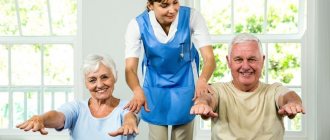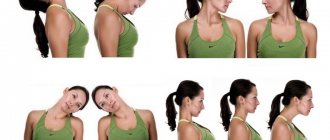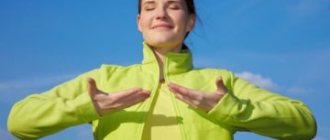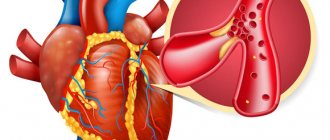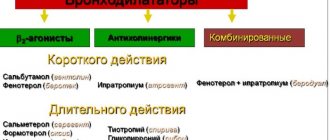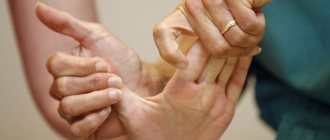Main complex
Vegetative-vascular dystonia is accompanied by attacks of suffocation, shortness of breath, and lack of oxygen.
Hypoxia causes disturbances in heart rhythm. With pathology, patients experience increased blood pressure, dizziness and lightheadedness. A symptom complex appears when a person’s nervous system is excessively anxious; the patient needs to eliminate oxygen starvation. In order to eliminate attacks in the initial stages of the pathological process, you should not immediately use antidepressants and other potent medications. The patient is advised to stabilize respiratory function. For this purpose, a set of exercises is performed. Thanks to special breathing, the body is saturated with oxygen, which leads to the normal functioning of the brain and heart.
During the period of gymnastics, the chest is completely filled with oxygen. When performing exercises, it is recommended to use the lungs, diaphragm and abdomen. During the manipulation, you need to set the breathing rhythm. It should be synchronous with physical activity. When performing the manipulation, it is recommended to inhale through the nose and exhale through the mouth.
If a person strictly adheres to the principles of doing gymnastics, this will have a positive effect on the result.
In order to improve breathing with vegetative-vascular dystonia and the patient’s condition in general, daily implementation of the basic complex is recommended:
- The first exercise is quite simple. It consists of rhythmically inhaling and exhaling several times. When performing the manipulation, it is recommended not to open your mouth. Next, you need to take several breaths in and out with your left nostril closed. At the next stage, the manipulation is repeated with the right nostril closed.
- Breathing is carried out using the abdominal muscles. When inhaling through the nose, the abdomen is rounded as much as possible. When you exhale, you need to draw it in.
- When inhaling, the stomach remains motionless. In this case, you need to work with your chest. The air is released through the nose.
- The next manipulation involves inhaling, during which the lungs expand and the stomach rounds. When exhaling smoothly, the abdominal wall is initially drawn in, and then the chest. When performing the exercise, one hand should be on the stomach and the other on the chest.
- When air is inhaled, the lungs expand and the abdomen retracts. When you exhale, the chest retracts and the stomach rounds. Breathing is carried out through the nose.
- The breathing rhythm is gradually slowed down, and after that it is smoothly and evenly increased to normal.
- At the next stage, a combination of breathing exercises and physical activity is recommended. The patient should walk slowly while maintaining proper breathing. When performing the exercise, you need to ensure that walking and breathing are synchronous. The duration of the manipulation is several minutes.
- The exercise is performed in a standing position. Your feet should be placed together and your hands should be at your sides. As you exhale, it is recommended to raise your arms up to the sides, and as you exhale, lower them.
- The next manipulation involves rotating your arms at your shoulders while breathing voluntarily. The movements should be performed back and forth.
- At the final stage, slow nasal breathing is performed. After this, it delays for a few seconds and resumes again.
A set of exercises will bring a positive result in treatment only if it is performed correctly. To avoid the development of complications, the patient is recommended to first consult with a doctor.
For gymnastics to have a positive impact, it must be done correctly:
- Breathe through your nose. This way the air is heated, humidified and purified. If oxygen enters through the mouth, harmful elements and dust enter the lungs.
- Take full breaths. The process involves: the chest, diaphragm and muscles of the anterior abdominal wall.
- Inhale and exhale correctly. Gymnastics for VSD involves inhaling, during which the chest first expands, and then the abdominal muscles. During exhalation, the stomach first contracts, and then the chest narrows.
- Synchronize movements and breathing. As you inhale, your arms spread to the sides or rise. Exhalation is accompanied by squatting, bending or bringing your arms together.
- Complement breathing exercises with sports. Yoga, aerial yoga, Pilates and exercise therapy for VSD help relieve spasm of the spinal muscles, thereby having a beneficial effect on the supply of oxygen.
Good results only appear if you practice regularly.
Why do breathing problems occur with VSD?
The following symptoms are observed with VSD:
- Cardiological. The rhythm and frequency of the heart change, and pain appears in this area.
- Respiratory. Breathing problems arise, there is a lack of air, shortness of breath.
- Psychological. Anxiety, panic, fear, and suspiciousness intensify.
This is the body's reaction to psycho-emotional experiences. Difficulty breathing in patients with VSD is a subjective feeling of lack of air caused by increased emotionality. It seems to a person that when the condition worsens, suffocation, a heart attack, and even death are possible. With complete calm, these symptoms disappear.
Hyperventilation syndrome can appear at a time of intense stress in a person.
- A feeling of incomplete inhalation or inability to inhale completely. This feeling becomes stronger in crowded places, with increased excitement.
- Heaviness in breathing and “lump in the throat.” There is a feeling of tightness in the chest, an obstacle to the passage of air. Therefore, inhalation is difficult and incomplete. There may be a long-term feeling of a “lump in the throat” as an independent symptom.
- Shortness of breath. It may be interrupted and stopped, and there is a fear of suffocation.
VSD is characterized by a wide range of symptoms, including:
- Cardiac – changes in the frequency and nature of the heart rhythm, sharp or dull pain in the heart area and increasing panic.
- Respiratory – shortness of breath, breathing problems, feeling of pressure in the chest, lack of air.
- Psychological – panic, anxiety, suspiciousness.
Such patients with VSD do not have serious pathologies of the heart and respiratory system that could cause these symptoms. These signs are the body’s physiological reaction to emotional experiences. The famous professor-psychologist Kurpatov noted the relationship between anxiety disorders and the manifestations of symptoms characteristic of VSD.
After complete calmness, these conditions disappear. And with a detailed examination, doctors do not find any signs of heart failure, asthma or other serious illnesses in the patient.
Features of the development and treatment of VSD
The autonomic nervous system (ANS) is responsible for the functioning of systems and organs in the human body. When its functioning is disrupted for some reason, it negatively affects the functioning of other parts of the body. The vegetative system consists of two sections that are interconnected.
One of them is responsible for relaxing the body, and the other is responsible for tension. And if a failure occurs in one of these departments, then the body will be either in a relaxed or tense state, which is wrong in both cases. The reasons for the development of autonomic dysfunction can be varied, but the problem is psychological in nature. Although pathology can arise from diseases.
A malfunction in the functioning of the VNS manifests itself as follows:
- sudden surges in pressure;
- headaches, dizziness;
- fainting, weakness, irritability;
- pain in the heart area;
- breathing problems: shortness of breath, suffocation;
- nausea and vomiting;
- sleep disturbance;
- hot flashes, chills;
- frequent urination, increased sweating;
- panic attacks, fear, anxiety.
If you have symptoms, you should consult a doctor who, after diagnosis, will diagnose vegetative-vascular dystonia and prescribe comprehensive treatment. The main stage of VSD therapy is communication with a psychotherapist. It will help normalize the psycho-emotional state and relieve the patient of panic and fear. The initial stages of therapy are not complete without drug therapy and non-drug treatment, some of which include sports activities.
Performing a massage after exercise
It is recommended to supplement breathing exercises with sports. Together, their effectiveness increases. Exercises for VSD at home include simple exercises:
- turns the body with stretching of the arms;
- raising the legs with knee bending and straightening;
- circular movements with hands;
- pressing palms against each other;
- raising your arms up and to the sides with your back arched.
Useful for VSD:
- swimming;
- run;
- a ride on the bicycle;
- aerobics;
- fitness.
Before starting to engage in these sports, it is advisable to consult a doctor. Running, fitness and cycling may have contraindications related to the spine.
With the hypotonic type of VSD, the emphasis is on strength exercises of large muscle groups. Classes are held at a slow pace. Strength exercises raise blood pressure and oxygenate the blood. This is important for hypotensive patients.
With the hypertensive type of VSD, aerobic exercise will help. It is useful to swim, dance, ride a bike, and walk in the fresh air. These exercises help lower blood pressure by dilating blood vessels and saturating the body with oxygen.
With a mixed type of VSD, exercises are combined. It would be useful to consult your doctor. The doctor will select a set of exercises taking into account the characteristics of the patient’s body.
During an attack of panic attack, you need to lie with your back on a hard surface. Arms are bent at the elbows, palms and fingers are pressed tightly against each other. The hands drop and relax. Thumbs touch chest. Hands don't strain. The legs bend, the knees spread apart and relax. The feet and toes are pressed together. It is recommended to stay in this position for 10 to 40 minutes.
The body relaxes, blood pressure returns to normal, and the level of adrenaline in the blood drops. Thanks to this, the panic attack goes away.
Carrying out a massage for VSD immediately after physical activity is not recommended. Light muscle work is shown.
You can do the massage yourself or seek help from a professional.
To cope with breathing problems, you need to exercise regularly. This will have a positive effect on the emotional and physical state of the body.
The following breathing exercises are effective:
- Rhythmic breathing. Inhale and exhale at a rapid pace through the nose. The task can be complicated. To do this, take 3 rhythmic breaths through the nose and a short exhalation through the mouth.
- Ventilation of the lungs. Breathing is carried out through the nose, using the chest and abdomen. As you inhale, you need to press your hands on the expanding area to increase resistance. At the same time, the breath becomes fuller and deeper.
- Chest breathing. The anterior abdominal muscles are not used. To exercise control, hands are placed on them. A large volume of oxygen is inhaled, the chest expands as much as possible.
- Abdominal breathing. The exercise is the opposite of the previous one. The chest is motionless. Inhalation is done using the abdominal muscles. When oxygen enters, the stomach protrudes, and when you exhale it contracts. To control, it is recommended to place one hand on the chest, the other on the peritoneum.
- Three-phase breathing. Inhalation, breath holding and exhalation are done through the nose and last for 5 seconds. Each time it is necessary to reduce the breath-hold by 1 second, and increase the exhalation proportionally. At the end of the exercise, inhale for 5 seconds, hold your breath for 0 seconds, and exhale for 10 seconds.
The author of this gymnastics is the famous teacher and singer Alexandra Nikolaevna Strelnikova. This complex helps restore voice and breathing, and also generally heals the body. It is used by professional opera singers and actors to treat speech disorders such as stuttering.
The Strelnikova complex will also be useful for vegetative-vascular dystonia. Exercises normalize previously disturbed breathing through the nose, provide pulmonary drainage, improve autonomic reactions, strengthen the heart and blood vessels, increase the overall tone of the body and immunity.
Alexandra Nikolaevna Strelnikova
Strelnikova’s complex includes many different exercises, here are just a few of them:
- “Pump“: stand up straight with your arms down and your feet shoulder-width apart, relaxing the muscles of your arms and shoulder girdle. Bend slightly forward, lowering your head, arms and shoulders. When bending over, take a quick breath, and when bending back, exhale. After every 8 breaths, pause for 5 seconds.
- “Cat”: squats are performed with simultaneous turns from the position: arms pressed at the seams, legs wider than shoulders. Do a squat with a torso turn, while raising your arms to your waist, and inhale quickly. Then, exhaling, shake the hands and turn in the other direction. After every 8 turns, pause for 8 seconds.
- “Big pendulum”: a slight inclination is made towards the floor, which is accompanied by inhalation. Then you need to straighten up and lean back a little, put your arms around your shoulders and bend at the lower back. After this, a calm, long exhalation is done.
Allowed sports
For a professional athlete, the symptoms of VSD are “unpleasant surprises,” but even they are not immune from this. However, certain sports gradually reduce the severity of symptoms. Therefore, they are used for complex treatment of patients with this diagnosis.
The permitted types of physical exercises for vegetative-vascular dystonia include:
- Ordinary jogging outside or on a treadmill - regular jogging improves your well-being, normalizes blood pressure and blood sugar.
- Step aerobics strengthens the cardiovascular system and normalizes blood circulation throughout the body.
- Badminton develops coordination of movements and does not require large amounts of energy.
- Swimming is a universal exercise that has a positive effect on the human body and normalizes the functioning of all organs.
- Morning exercises - gentle stretches, bends and twists strengthen the heart muscle and increase the tone of the body.
Breathing exercises for VSD: techniques and exercises
The principle of deep slow breathing is widely used in yoga, where there is a special breathing technique - Pranayama. It is performed before starting a set of asanas, usually in combination with meditation. Pranayama literally translates as energetic breathing. Yogis believe that the air contains not only oxygen, but also vital energy - prana, which is inhaled to increase energy levels.
A distinctive feature of Pranayama is a slow, conscious inhalation, during which the chest, upper part of the lungs, diaphragm, and abdomen are filled with air, and then a delay and slow exhalation. To perform this technique, you need to sit cross-legged or take the well-known lotus position with your back straight.
Not all breathing exercises are useful for patients with VSD. Breathing should be measured, even slow. Sharp inhalations and exhalations are contraindicated: they can provoke vasospasm, increased anxiety - and therefore aggravate symptoms during an attack of VSD.
Breathing exercises, as well as active physical exercises, are contraindicated for patients who have recently suffered strokes, heart attacks and other acute conditions. In this case, classes can begin after the condition has stabilized and under the supervision of a doctor.
General principles of therapeutic breathing for VSD:
- Regularity and rhythm of breathing.
- You need to start gymnastics with several repetitions of the exercise and a minimum time of holding your breath, gradually increasing them.
- Therapeutic breathing should not cause discomfort, cause severe dizziness, darkening of the eyes - often in patients with VSD, these symptoms occur in the first days of performing breathing exercises. If unpleasant symptoms appear, you need to take a break and then perform the exercises at a slower pace.
- Movements during therapeutic breathing should be smooth, without sharp turns or bends.
- While performing a set of exercises, you cannot be distracted. Full concentration on the process will help calm your nerves and reduce anxiety.
- It is better to perform breathing exercises for VSD on an empty stomach, several times a day (ideally 3 times: in the morning, at lunch and before bed).
- You need to inhale the air through your nose: this way it is further purified and moisturized.
- It is advisable to learn how to breathe with your stomach: this ensures maximum ventilation of the lungs.
- If breathing is accompanied by movement and simple physical exercises, you should inhale when straightening movements, and exhale when bending, squatting, or lowering your arms. This will allow you to correctly distribute the load during exercise, not lose the rhythm, and evenly saturate the muscle tissue with oxygen.
Breathing exercises
Breathing practices according to Buteyko
This is a very simple set of exercises for VSD; it should be performed on an empty stomach, three times a day.
You need to sit with a straight back, with your knees slightly bent, keeping your stomach and diaphragm relaxed.
First, a control sample is taken to determine the level of carbon dioxide in the body. To do this, you need to breathe evenly and calmly for a while, then hold your breath for 15 seconds. If there is a lot of carbon dioxide, then the delay will pass quite easily.
Then a weak, light breath is taken through the nose, while the stomach remains relaxed. Inhale for two seconds and exhale more slowly for 4 seconds. You need to breathe like this for at least 5 minutes. Then perform a control test again and repeat the procedure 2-3 more times. In total it takes no more than 15-20 minutes.
For patients with VSD, it may be difficult to perform this exercise, since at first it can be difficult to ensure that the chest and abdomen remain motionless. But the result justifies the difficulties in mastering it: after just a few days, sleep normalizes, suffocation disappears, a runny nose goes away almost immediately, and after a month shortness of breath disappears.
This breathing exercise for VSD is aimed at relieving the symptoms of suffocation, partially calms the nervous system, but does not affect other symptoms. It will be useful for patients with insomnia - in this case, you should definitely do gymnastics before going to bed.
Exercises are performed in a sitting position. It is better to use a chair with a back so that your back muscles do not strain. The back should be straight, legs slightly bent at the knees. The stomach and chest should feel free throughout the entire set of breathing exercises.
Shallow breathing helps you concentrate as much as possible on the process of gymnastics. Inhale through the nose in two counts. The chest and stomach should remain motionless. Next - an exhalation extended for 4 seconds, and the same pause.
You need to breathe in this way for at least five minutes. Afterwards, perform the first exercise with holding your breath.
This system requires special attention, since in addition to VSD it helps patients with bronchitis, rhinitis and bronchial asthma. The basis of the technique is to adjust the level of carbon dioxide in the patient’s blood, which helps stabilize the functioning of the respiratory center. Gymnastics also has a second name - “life by inhalation.” To perform it correctly, you must follow these instructions:
- The patient sits upright and completely relaxes.
- After this, a shallow inhalation and exhalation is performed, in the middle of which you need to hold your breath.
- This pause should be about 20 seconds.
- Now a smooth nasal inhalation is made. The chest or abdomen should not be used, but should be kept in a relaxed state. It is necessary to ensure that the lungs are not overloaded, as if working in superficial mode.
- Next, the proportions of inhalation-pause-exhalation are 2:4:4 seconds.
The above-described exercise during VSD should last five minutes. This is followed by rest and the procedure can be repeated.
Consequently, vegetative-vascular dystonia is not recognized by modern medicine as a serious disease. Nevertheless, this syndrome can significantly worsen the patient’s quality of life. An effective remedy for stopping an attack is breathing exercises for VSD. These simple techniques can quickly suppress shortness of breath and other uncomfortable sensations that are psychological in nature.
How to breathe correctly during panic attacks?
The sudden appearance of a feeling of fear of death and unexplained severe anxiety may be due to the reaction of the autonomic nervous system to negative experiences and stress. Everyone can get out of this situation on their own if they know how to normalize breathing during panic attacks.
How to deal with sudden panic attacks?
A panic attack can strike at any moment. It is impossible to predict it.
Frequent experiences and accumulation of problems can provoke sudden rapid heartbeat, trembling, cold sweat, and lack of air.
This condition requires consultation with a neurologist, but you can relieve the main symptoms on your own. Breathing exercises during panic attacks will help calm the nervous system and prevent subsequent attacks.
When severe anxiety and fear arise, it is difficult for a person to take a full breath or exhale. The respiratory rhythm is disrupted. If you do not bring it back to normal in the first minutes, the situation may worsen, and this will lead to sudden suffocation, vasoconstriction, and loss of consciousness.
People prone to panic should know how to help themselves. This condition does not threaten a person’s life, but learning to cope with it will help to avoid similar unpleasant sensations in the future.
Breathing exercises for panic attacks
Methods of respiratory correction consist in the fact that with the help of breathing exercises a spasm in the throat is eliminated, the lungs are provided with air during hypoxia, and other symptoms are relieved.
There are several ways to normalize this condition. They need to be mastered not at the moment of crisis, but in advance, so that all the techniques can be worked out until they become automatic. Everyone can, if desired, choose the most suitable one and use it at the right time.
Belly breathing technique for panic attacks
During attacks, it is important that the functioning of the nervous system is restored as soon as possible; a technique such as belly breathing during a panic attack will help restore it.
Mindful breathing using the diaphragm (without moving the chest) is an effective remedy. It allows you to saturate the body with oxygen and normalize the sympathetic nervous system.
The person should take a comfortable position - lying or sitting. To achieve maximum effect, you need to relax the shoulder girdle area and breathe freely.
Then you should put your hand on your stomach to control its movements. During inhalation (3-4 counts), the lungs are filled with air as much as possible, while the stomach rises.
Then hold your breath for 1-2 counts. The exercise ends with a slow exhalation (5-6 counts), during which the front wall of the abdomen lowers (at the end the abdomen must be pulled in).
After a short pause, the exercise is repeated.
Breathing in a square
This method of calming down is widely used in Eastern breathing practices. It is easy to do and quite effective. Breathing during exercise should be smooth.
Inhalation is done through the nose slowly on a count of 1-2-3-4, followed by holding the breath, which lasts the same amount of time. As you exhale, you should also count to four and pause before the next inhalation. It is advisable to exhale through the mouth. During the pause after exhaling, you should smile or imagine yourself smiling. This will quickly relax the muscles.
Experts advise that when performing this exercise, find with your eyes an object in the shape of a square or similar to this figure (window, picture, TV, house) and move your gaze from one corner to another. Thus, all stages of this technique will be simultaneously recorded with the gaze.
Result: the body gets rid of carbon dioxide formed when the respiratory rate increases, the release of adrenaline is blocked, and the muscles relax.
Breathing into a bag during panic attacks
There is another way to improve your condition during neuroses or depression - breathing into a bag. In this case, you need to bring the bag to your mouth and take a deep, long breath in through your nose, and then exhale through your mouth. With the subsequent inhalation, part of the CO2 will enter the body; this is necessary so that its ratio with oxygen becomes balanced.
In the absence of a package, this technique can be applied using the palms of the hands, but this will not give much effect. In such cases, it is better to turn to other exercises.
Proper breathing during panic attacks can stop the attack within a few minutes.
Breathing method counting 5-2-5
You can get rid of hyperventilation by breathing on a count of 5-2-5.
This technique is as follows: the first 5 seconds - inhale (breathing should be diaphragmatic, but not chest), then 2 seconds - hold your breath, over the next 5 seconds - calm, slow exhalation.
You need to repeat the exercise 2 times, and then take a break and breathe in the usual way. After relaxing, repeat everything again. Number of approaches - 5.
For any nervous tension, you can use the described techniques, in which slow, deep breathing ensures normalization of the functioning of the nervous system.
Source: https://eustress.ru/panicheskie-ataki/dyhanie-pri-panicheskih-atakah
Strelnikova method
To achieve the highest therapeutic effect of gymnastics for vegetative-vascular dystonia, the use of the Strelnikova method is recommended. The manipulation consists of simultaneously performing breathing exercises and physical exercises:
- The upper limbs bend at the elbows and extend upward. Hands are located above shoulder level with the inside of the face. A short breath is taken, during which you need to clench your palms and unclench them.
- We are in a standing position and straighten our back. We lower our hands at the seams. On a short inhalation, we sharply move our arms using the downward push method. After this, the palms unclench. Next, the shoulders tense and the fingers unclench, holding them in their original position. As you inhale, return to the original position.
- Manipulations are performed in a standing position. Feet are shoulder width apart. And my hands are at my sides. We lean forward slightly, lowering our head and shoulders. In this case, the muscles should be as relaxed as possible. At the end of the tilt, inhale, and after returning to the starting position, exhale.
- In a standing position, your arms drop down and your legs spread wide. We take a quick breath and squat during this period. In this case, the body turns to the right side, and the arms rise to the waist. As you exhale, return to the original position and relax your arms.
- The patient is in a standing position and flexes the upper limbs at the elbow joint. Hands should be shoulder-width apart, with palms facing each other facing inward. The fingers are in a relaxed position. A person should try to hug himself. Inhale while placing your hands in the sternum area. During the exhalation period, the arms are spread to the sides.
- During the inhalation period, we make a slight tilt to the right side, and as we exhale, we return to the original position. Next, the manipulation is carried out in the same way, only we tilt it in the opposite direction. When performing the exercise, you need to use the neck muscles.
- As you inhale, bend down a little. We straighten up and bend a little in the lumbar region. During this period, we hug ourselves by the shoulders. After this, exhale smoothly and evenly.
- In a standing position, straighten your back. As you inhale, your head leans against your left shoulder. When returning to the original position, you need to exhale. The manipulation is then performed according to the same algorithm only in the opposite direction.
- The patient remains in the same position and places his feet shoulder-width apart. During inhalation, the head lowers and smoothly tilts back. During this period, you need to take a breath again. A person must exhale between breaths.
- We put our right leg forward and distribute the weight evenly. After this, you need to move it to your right leg, squat down shallowly and inhale. The knee straightens and the weight is transferred to the other lower limb. While squatting on your left leg, you need to inhale again. Exhalations should be done between squats.
- One leg is raised in a bent position at the knee. After this, we do a squat with support on the second leg and inhale at the same time. At the next stage, straighten the knee and exhale quickly. The exercise is repeated after changing the position of the legs.
When performing the complex, the patient must monitor his well-being. If it worsens, it is recommended to stop gymnastics and consult a doctor.
It is not a specially developed medical set of exercises. The effectiveness of this exercise has not been proven in clinical trials. But, according to reviews from many patients, such gymnastics helps to significantly improve the condition and reduce the frequency of attacks during VSD.
In addition to the calming effect during VSD, this set of breathing exercises allows you to improve nasal breathing and lung ventilation, improves vascular tone, and helps improve posture.
A set of breathing exercises for VSD according to Strelnikova:
- I.p. standing straight, arms bent at elbows at shoulder level, palms turned away from you. Elbows are not pressed to the body. A short inhale through the nose is accompanied by clenching of the palms, and exhalation through the mouth is accompanied by straightening of the fists. Take 8 such breaths, then a five-second pause and another round of exercises. It is better to start gymnastics with this warm-up exercise.
- I.p. standing, arms pressed to the body, fists clenched. Inhale through your nose, lower your arms lower, tense your shoulders, unclench your fists, spreading your fingers as far as possible. While inhaling, return to I.p. repeat 8 times, then take a 3-second break and repeat the exercise.
- I.p. standing, legs wider than shoulders, arms at chest level, elbows bent, palms facing each other. When you try to hug yourself by the shoulders, take a breath. When you straighten your arms to the sides, exhale. Do 8 breathing cycles, then take a break for a few seconds. In total you need to perform 12 approaches.
Sports for all-round sports: what types can you do – Izvilina
Vegetative-vascular dystonia is a complex of functional disorders in which a disorder in the regulation of vascular tone of the autonomic nervous system is diagnosed.
If symptoms of the disease appear, the patient is recommended to consult a specialist who, after conducting appropriate diagnostics, will prescribe effective treatment. The doctor will tell you whether it is possible to play sports with VSD, based on the patient’s physical condition.
Permitted and prohibited sports
Sports with VSD are allowed to a large number of patients. But experts prohibit certain types. If the vascular type of disease occurs in a professional athlete, then he is recommended to give up regular grueling exercise.
During the course of the pathological process, the patient is allowed moderate physical activity, since their effect is positively reflected in the treatment of the pathological process.
The concepts of sport and VSD are often inseparable. During the course of the disease, patients are allowed to run and swim. Patients are recommended to do morning exercises daily. In case of pathology, it is allowed to practice yoga and step aerobics. A safe sport for VSD is badminton.
If the pathology begins to dictate, then the patient needs to give up excessive physical activity.
It is prohibited to engage in:
- Weightlifting;
- Bodybuilding;
- Discus throwing;
- Armwrestling;
- Kettlebell lifting;
- Martial arts;
- Powerlifting.
With vegetative-vascular dystonia, patients are advised to give up chess. This is explained by the fact that during the game the patient experiences emotional overload.
Chess players stay in one position for a long time. In the absence of physical activity and a simultaneous surge of emotions, the patient may develop a hypertensive crisis.
Physical activity during VSD in the gym is allowed subject to certain rules. The patient is advised to adjust his lifestyle. The patient must maintain a regimen of activity and rest.
A healthy night's sleep should last at least 8 hours. The patient is recommended to provide a balanced diet with foods rich in potassium and magnesium.
When visiting the gym, it is strictly forbidden to allow excessive physical overload. During exercise, the patient should regularly monitor pulse and blood pressure. Manic control of indicators can lead to neurosis and a decrease in the effectiveness of classes.
Martial arts are characterized by the presence of certain restrictions. The patient is advised to avoid competitions and sparring. It is not recommended to engage in acrobatics, gymnastics, and figure skating, as they belong to the category of traumatic sports.
Water aerobics and aerobics have a positive effect on the body, which is why most doctors recommend them for pathology.
There are various sports that are allowed to a patient with vegetative-vascular dystonia. This allows a person to choose the most suitable option for himself. Prohibited sports should be abandoned, which will eliminate the possibility of developing complications of the pathological process.
Basic recommendations
With vegetative-vascular dystonia, sports are allowed only if certain recommendations are followed. Physical activity in which the patient is upside down is not permitted. It is not recommended to perform deadlifts, as this can negatively affect the condition of blood vessels. To avoid excessive overload, overheating is not recommended.
Any physical activity should not cause discomfort in the patient. If they appear, you should stop doing the exercise and consult a doctor. Don't overstrain your body. Physical education should have a positive effect on the physical and psycho-emotional state of the patient.
If dystonia occurs in a mild form, then before engaging in a certain sport, a warm-up is recommended. Between approaches to classes, the patient must provide himself with rest. During the period of vegetative-vascular dystonia, thirst is contraindicated. That is why a person should take water with him.
Playing sports with moderate VSD requires avoiding heavy lifting. During physical activity, it is recommended to drink water periodically. Before performing certain exercises, it is recommended to consult not only a doctor, but also a fitness trainer. The specialist will create an individual training program, which will have a positive effect on the patient’s condition.
If the pathological process is severe, then visiting gyms is contraindicated for the patient. He must perform a minimum set of exercises at home. The patient must remember that physical overexertion can lead to a vegetative crisis, which will negatively affect the condition of the heart and blood vessels.
In case of vegetative-vascular dystonia, the patient must adhere to the recommendations, which will eliminate the possibility of undesirable consequences.
Features of training
One of the best sports for the disease is vegetative-vascular dystonia. During classes, almost all muscles are involved and the body is fully functioning.
There is an improvement in oxygen supply to all systems and internal systems. The training process must be approached correctly and using a specific plan. The patient should gradually increase the intensity of training, which will eliminate the unpleasant symptoms of the disease.
With this approach, the heart muscle will gradually get used to pumping large volumes of blood. This will lead to improved brain activity and a full supply of oxygen.
With regular exercise, there is an improvement in thought processes and the elimination of depressive states, neuroses and psychoses. This will eliminate stressful situations in vegetiovascular dystonia. Running is a public sport. Classes can be held outdoors completely free of charge.
In order to maintain good physical shape, the patient is recommended to engage in fitness. Thanks to a universal set of exercises, all muscle groups, as well as the cardiovascular and immune systems, are strengthened. The action of fitness is aimed at losing weight and maintaining overall tone. Fitness provides the body with endurance.
Regular exercise leads to increased strength and flexibility, as well as rejuvenation of the body. Thanks to this effect, irritability is relieved and the possibility of developing stressful situations is reduced. With regular exercise, a decrease in the severity of dystonia symptoms is observed.
If you are ill, you are allowed to engage in skiing, horseback riding, and cycling. In this case, one important condition must be observed. The patient's movement should be smooth.
In a pathological process, a large number of sports can improve the patient’s condition and eliminate negative symptoms.
Home activities
If a person does not have enough time to visit the gym, then to improve his health with VSD, he can perform gymnastics at home. It is carried out according to a specific plan:
- We are in a standing position and place our feet shoulder-width apart. We perform simultaneous circular movements with both hands. The duration of the manipulation in one direction is 12 seconds.
- We remain in the same position, bend our elbows, and align our palms with each other. A person should try to squeeze his palms as hard as possible for 20 seconds. The procedure is performed in 6-7 approaches.
- In the same body position, place your hands on your hips. Slowly turn your head in all 4 directions in turn. The manipulation is repeated 5-7 times.
- In a standing position, place your hands on your shoulders. We perform circular movements forward and backward 5-7 times.
- The next step is stretching. The patient can use any method he likes.
- At the final stage, it is recommended to perform statistical exercises. Hands are on the belt. In this case, the patient should try to maintain balance. We raise one lower limb, which bends at the knee. When it becomes parallel to the floor, we pause for a few seconds. After returning to the starting position, we repeat the manipulation only on the second leg.
Vegetovascular dystonia is not a death sentence. A person can lead a full life. During the course of the pathological process, certain sports are allowed. During the training period, the patient must adhere to the basic recommendations, which will have a positive effect on the course of the disease.
Source:
VSD and sports: physical activity for vegetative-vascular dystonia
Have you ever suddenly felt like you were going to faint when you were doing too much physical activity? Suddenly you turn pale, break out in a cold sweat, and your vision becomes dark. However, the situation may develop in a different scenario: a sharp increase in blood pressure, redness of the skin, dilation of the pupils. Some may even experience panic attacks.
Vegetative-vascular dystonia is a complex of functional disorders based on dysregulation of vascular tone of the autonomic nervous system. When such conditions occur, you need to stop any physical activity and even if you have not been sick before, consult a doctor.
VSD and sports are compatible, but in the right quantities and as prescribed by a specialist.
Description of the disease
VSD, according to modern medicine, is observed in 70% of the population, but only a third of these cases require therapeutic or neurological assistance.
The first symptoms of vegetative-vascular dystonia most often occur in childhood or adolescence, fully manifesting themselves by the age of 20-40. According to statistics, the fair sex is susceptible to VSD three times more often than men.
Today, medicine does not consider VSD as an independent disease, because, in fact, all its manifestations are symptoms that develop against the background of organic pathology.
After conducting appropriate examinations, doctors will diagnose you and prescribe treatment.
So, you have undergone examinations, taken an electrocardiogram, and the doctors say that you have VSD - the question arises, what to do? Yes, this functional disorder significantly impairs the quality of life. But you need not to panic and try to live your best life, following the doctor’s recommendations. Let's try to figure it out, you can lick sports with VSD.
Important! This article will not help you accurately determine whether you suffer from VSD. Only a doctor has the right to make a correct diagnosis. Self-medication is contraindicated and even dangerous.
Physical activity for VSD
Vegetative-vascular dystonia and sports are completely compatible concepts, although it is still not advisable to engage in some sports.
Source: https://fiz-disp.ru/lekarstva/sport-pri-vsd-kakimi-vidami-mozhno-zanimatsya.html
General provisions
Many patients complain of discomfort that occurs during exacerbation of VSD. One of them is difficulty in breathing, which can resemble asthmatic suffocation. The patient feels an urgent need for oxygen, but his breathing is shallow. As a result, headaches, anxiety and unreasonable fear, as well as dizziness, may occur.
With such symptoms, a thorough diagnosis is carried out. It is aimed at detecting problems with the respiratory system. If the examination did not reveal the causes of this condition, then modern medicine insists on the psychological aspect.
The main causes of VSD are considered to be stress and increased physical activity. Soreness can cause ordinary neurosis resulting from a panic state. In this case, the patient is indicated for complex treatment, which involves breathing exercises.
If shortness of breath is detected during VSD, professor of psychology Kurpatov recommends the following:
- In the absence of coronary sclerosis confirmed by ECG, shortness of breath should be considered a subjective sensation. It is very important for the patient to understand that such ailment is mental in nature.
- When symptoms of VSD appear, the patient should calm down and try to breathe correctly. This will reduce the manifestations of the syndrome.
- Fear of loss of consciousness or death in such cases is not uncommon. Therefore, the patient needs to understand that these sensations have no real basis. When breathing becomes difficult, protective mechanisms are usually activated that prevent the body from dying.
- A sober assessment of the situation helps normalize breathing. After looking at those around him, the patient needs to convince himself that the people nearby are not suffering from a lack of oxygen and try to calm down.
Recommendations
Before carrying out physical activity during VSD, you need to inquire and understand which type of sport is suitable for you and will not lead to adverse consequences. When carrying out physical activity, you should not overload your muscles, training beyond your capabilities or at their limit. After physical training there should be no discomfort or pain.
Recommendations:
- when combining VSD and sports, select only active exercises that have good motor strength,
- To avoid anxiety and phobias about the harm of these exercises, do not check your blood pressure and pulse parameters immediately after physical exercise,
- the load must be increased gradually, starting with the minimum permissible number of exercises,
- classes should be held outdoors or in a ventilated area.
Pain during vegetative-vascular dystonia is an unpleasant sensation that occurs individually and functions as an alarm signal. It plays an important role in maintaining health because it is a warning mechanism that indicates that something wrong deserves attention. Several psychological and anthropological studies have shown that in humans, pain and other symptoms of VSD do not depend solely on the degree of organ damage, but can occur even in the absence of organic damage or dysfunction.
The intensity and nature of VSD symptoms are also influenced by past experiences, memories, and the ability to understand their causes and consequences.
Physical activity within a broad concept can be understood as a natural but complex and multi-step phenomenon that influences and is influenced by biopsychosocial aspects. Therefore, physical activity can have a positive or negative effect on a person with a psychosomatic illness.
In winter you can go skiing or skating. There are restrictions for martial arts; such game sports are permissible only without participation in sparring and, especially, competitions. You can learn this skill from a technical point of view. Similar conclusions can be drawn regarding acrobatics, gymnastics and figure skating, because they often lead to injury and can cause significant harm. Aerobics and fitness can play an alternative role.
There are different types of physical activities, but not all of them are suitable for VSD. In athletics, any direction is allowed, in addition to pushing weights:
- kernels,
- hammer,
- disk,
- Pole vaulting is prohibited.
Nowadays, there seems to be almost universal agreement that systematic physical activity can provide many health benefits. Several studies have shown that the severity of VSD symptoms is associated with the practice of physical exercise, as well as increasing the level of physical activity, reducing the risk of morbidity from any cause, as well as controlling risk factors, such as:
- high blood pressure,
- blood lipids,
- high insulin resistance,
- obesity,
- low resistance to stress,
- moderate depression.
The link between excessive stress and body pain has been found in several studies. In this context, exercise can be beneficial and even preventive in the treatment of somatic pain, since it is largely associated with the reduction of tension.
However, there is a large gap in the literature regarding exercise practices or levels of physical activity for psychosomatic pain, especially among working people. Therefore, it is important to test whether there is an association between habitual physical activity and somatic pain among administrative employees of large and small companies.
Tibetan gymnastics
This set of exercises helps normalize breathing, stop an attack of suffocation, and calm the nerves during VSD. At the beginning of performing gymnastics, you may experience slight dizziness, which quickly passes.
First exercise: I.p. sitting on the floor with legs crossed, back straight. Close your right nostril with your thumb and inhale. Hold your breath for 16 seconds. Exhale freely through your mouth. Repeat the exercise on the left side. One approach – 4 exercises for each nostril.
The second exercise of Tibetan gymnastics for breathing: I.p. the same, but the hands are on the knees. Inhale through your nose, throwing your head back. As you exhale, press your chin to your chest. Perform 7 repetitions.
Third exercise: I.p. standing, arms along the body. Take a deep breath, raising your hands and cupping them back to back. Stretch upward, holding your breath. After exhaling some of the air, spread your arms 120 degrees. Then, on a full exhalation, return to I. p.
How to learn to breathe correctly during VSD
You can overcome shortness of breath that occurs with vascular dystonia by mastering proper breathing techniques.
To do this you need to follow these tips:
- Diaphragmatic breathing is carried out when not only the chest, but also the front wall of the abdomen takes part in inhalation. This process occurs as follows: the lungs expand, after which the chest expands. The last thing to do is raise the abdomen. Exhalation should involve the reverse order of these actions.
- Inhalation is carried out through the nose. This is very important because the air is not only purified by passing through the nostrils, but also moistened, becoming warmer. This helps to relax the respiratory system.
- Squats will help normalize breathing. While inhaling, the legs bend at the knees and the body lowers, and when straightening, you need to inhale.
Exercising with VSD: another way to saturate the blood with oxygen
Complete refusal of physical activity during VSD is a direct path to worsening the condition. Professional sports are not recommended for patients with VSD, but general strengthening exercises and light gymnastics are necessary. They help fight stress, normalize blood circulation, and increase endurance. In combination with breathing exercises, some sports help to achieve significant progress in the treatment of VSD.
Patients with VSD are recommended:
- Swimming in the pool. Water helps relax muscles, relieve stress, improve ventilation and breathing quality, as well as improve posture and reduce back pain - especially for those who are in one position most of the day. Also, water gymnastics – a set of exercises in water – won’t hurt.
- Pilates. A set of exercises that improves oxygen saturation of the lungs, helps strengthen the body, get rid of muscle tension and chronic pain.
- Yoga. Ancient gymnastics helps improve muscle elasticity and flexibility, relieves tension during VSD, improves concentration, and promotes deep relaxation.
- Cycling helps develop coordination and increases the ability to concentrate.
- A complex of general strengthening gymnastics.
conclusions
Patients with VSD are advised to spend more time in the fresh air, strengthen their muscles by walking and running, and improve their diet. It is necessary to rationally build a work and rest schedule and eliminate stress.
Sports for VSD help reduce the active symptoms of the disease and reduce its severity.
The following sources of information were used to prepare the material.
Vegetative-vascular dystonia, which occurs in every third inhabitant of the planet, is psychological in nature and occurs due to neurosis, stress, hysteria and neurotic disorders. VSD is not an independent disease, but is a complex of symptoms that develops as a result of dysfunction of the autonomic system of the human body. Autonomic dysfunction does not pose a serious threat to human health, but it significantly complicates the patient’s life, causing a lot of discomfort.
Performing basic breathing exercises
To generally improve the well-being of patients, the following exercises are used for VSD:
- Rhythmic nasal breathing. You need to start with smooth inhalations and exhalations, performed with a relaxed body. After this, breathing is carried out alternately through the left and right nostrils. Next, inhalations should be made in jerks, and exhalations should be rhythmic and through the mouth.
- Chest breathing. When the abdominal area is motionless, it is necessary to inhale air through the nose, while achieving maximum expansion of the chest. This is followed by a strong exhalation, which should be accompanied by a feeling of complete liberation of oxygen from the lungs.
- Abdominal breathing. Inhalation is carried out through the nose, while trying to stick out the stomach, leaving the sternum area motionless. Exhalation occurs with parallel retraction of the abdomen. Exhaling through your mouth will help you achieve calm.
- Full breath. Mixed type exercise. Performed at the last stage of classes. Involves a deep, measured breath, during which all the above-described departments are involved.
Panic attacks cause severe psychological stress. Due to the inability of most patients to overcome sudden emotions, a paper bag can be used to normalize respiratory function. Within a few minutes, this procedure allows the patient to completely calm down.
Reviews
Tatyana, 35 years old: “I have been suffering from VSD for many years. In recent years, panic attacks due to private stress have become more frequent. The doctor advised vegetotropic breathing. I chose Tibetan gymnastics for myself. Now I don’t do the exercises every day, but the effect of gymnastics has remained.”
Anton, 42 years old: “In recent years, blood pressure has increased more often, and VSD has worsened. I practiced independently using Strelnikova’s complex of gymnastics and breathing exercises and managed to achieve slight improvements. The pressure has stabilized and does not fluctuate so sharply. I began to feel more cheerful, the symptoms of VSD became less.”
Oksana, 19 years old: “I’ve had VSD since I was 8 years old, every session at the institute began to be accompanied by anxiety. I had seizures several times, it was hard to breathe, I almost fainted. I discovered breathing exercises. I don’t have time to study all the time, and I’m lazy. But as an emergency measure to calm down, in most cases these exercises help.”



